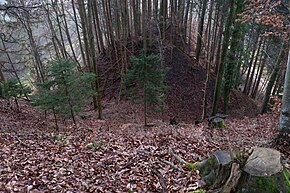Falkenhalden Castle
| Falkenhalden Castle | ||
|---|---|---|
|
Falkenstein Castle - View of the southwestern Spornspitze of Schlossbühl (January 2013) |
||
| Alternative name (s): | Falkenstein Castle | |
| Creation time : | Probably from the Middle Ages | |
| Castle type : | Höhenburg, spur location | |
| Conservation status: | Burgstall, moats and ramparts | |
| Place: | Deggenhausertal -Homberg- "Schlossbühl" | |
| Geographical location | 47 ° 47 '40.1 " N , 9 ° 24' 4.8" E | |
| Height: | 630 m above sea level NHN | |
|
|
||
The Falkenstein Halden , even Falkenstein Castle called, is a Outbound High Middle Spur castle on the "Schlossbühl" at 630 m above sea level. NHN above the Falkenhalden farm near Homberg , a district of the Deggenhausertal community in the Lake Constance district ( Baden-Württemberg ).
To this day, no precise information is known about the castle, of which only the stables , three moats and ramparts have survived. The castle site is one of the largest in the Lake Constance area.
history
Nothing precise is known about the history of this castle to this day, archaeological finds in the form of ceramic wall fragments from the southwest ditch and the wall in front of it prove an inspection already during prehistory , probably in the metal age . The spur was then used as a possibly fortified hilltop settlement. Later finds in 2004 from the area of the round pit in the inner castle date from the late Middle Ages.
The builders of this rather large castle complex are unknown, possibly the noble gentlemen of Deggernhausen. The first possible mention of the castle comes from the year 1171, when Abbot Diethelm von Reichenau mentioned half a mansus " in Ualchinstein " in an exchange deal with the Reichenau monastery . Later in 1213 the brothers Konrad, Heinrich and Diethart von Falkenstein were named together with other mostly local aristocrats in a document as King Friedrich II . This family, named after the castle, was of the nobility of the ministerial class and possibly served the Deggernhausers. As the builder of this large castle, they are not considered to be, they probably only inhabited the castle or areas of it. Other members of the family were Konrad von Falkenstein, mentioned in 1251, and Falkensteiner, who was mentioned in 1294 and also called himself Konrad. It is also the last mention of the Falkensteiner family. There is also no information about the departure of the castle, the former Falkenhalden farm, which was located east of the castle site, still existed in 1989, as an aerial photo from that time shows.
description
The castle was located on a spur protruding from the highest in a south-westerly direction , which is limited by two tributaries of the Deggenhauser Aach . In the northeast, the complex was protected by a still well-preserved neck ditch , which was deepened by a forest path. Towards the southwest, a plateau about 30 meters long and eight to ten meters wide forms a kind of outer bailey and ends at the about five meters deep embankment of a section trench that connects about ten meters high to the actual castle square. On the approximately 100 meter long Burgplatz there is a two meter deep, round depression, at the southwest end of the plateau there is a similarly deep and almost rectangular pit, both of which have not yet been scientifically investigated, but can probably be assigned to the castle. At the southwestern end of the area, a steep, approximately twelve-meter-deep embankment leads into another section trench with a towering wall rib, which is separated from the southwestern part of the spur by another section trench. The narrow surface of the spur was apparently still part of the fortification.
literature
- Michael Losse (Ed.): Castles, palaces, aristocratic residences and fortifications on Lake Constance and the Upper Rhine, Volume 1.2: Eastern part around Meersburg, Immenstaad, Friedrichshafen, Bermatingen, Markdorf and Deggenhausertal . Michael Imhof Verlag, Petersberg 2013, ISBN 978-3-86568-812-5 , pp. 112-114.
- Hansjürgen Brachmann : The early medieval fortifications in Central Europe. Investigations into its development and function in the Germanic-German area . In: Writings on Prehistory and Early History, Volume 45 . Akademie Verlag, Berlin 1993, ISBN 3-05-001995-6 .
- Alois Schneider: Castles and fortifications in the Lake Constance district . In: Landesdenkmalamt Baden-Württemberg (Ed.): Find reports from Baden-Württemberg . Volume 14. 1st edition. E. Schweizerbart'sche Verlagsbuchhandlung, Stuttgart 1989, ISBN 3 510 49114 9 , ISSN 0071-9897 , pp. 533-534.
Web links
- Falkenhalden on the leo-bw.de page
- Entry on Falkenhalden in the private database "Alle Burgen".
Individual evidence
- ↑ See the Markdorf administrative area . In: The state of Baden-Württemberg. Official description by district and municipality. Volume VII: Tübingen administrative region. Published by the Landesarchivdirektion Baden-Württemberg, Verlag W. Kohlhammer, Stuttgart 1978, ISBN 3-17-004807-4 . P. 565-578, here: Deggenhausertal b) Homberg , p. 572 f.
- ↑ Falkenhalden Castle on the andreas-utz.info page
- ^ Alois Schneider: Castles and fortifications in the Lake Constance district. P. 534.
- ↑ Michael Losse (ed.): Castles, palaces, aristocratic seats and fortifications on Lake Constance and the Upper Rhine, Volume 1.2: Eastern part around Meersburg, Immenstaad, Friedrichshafen, Bermatingen, Markdorf and Deggenhausertal , p. 113 f.
- ^ Alois Schneider: Castles and fortifications in the Lake Constance district. P. 533 f.




